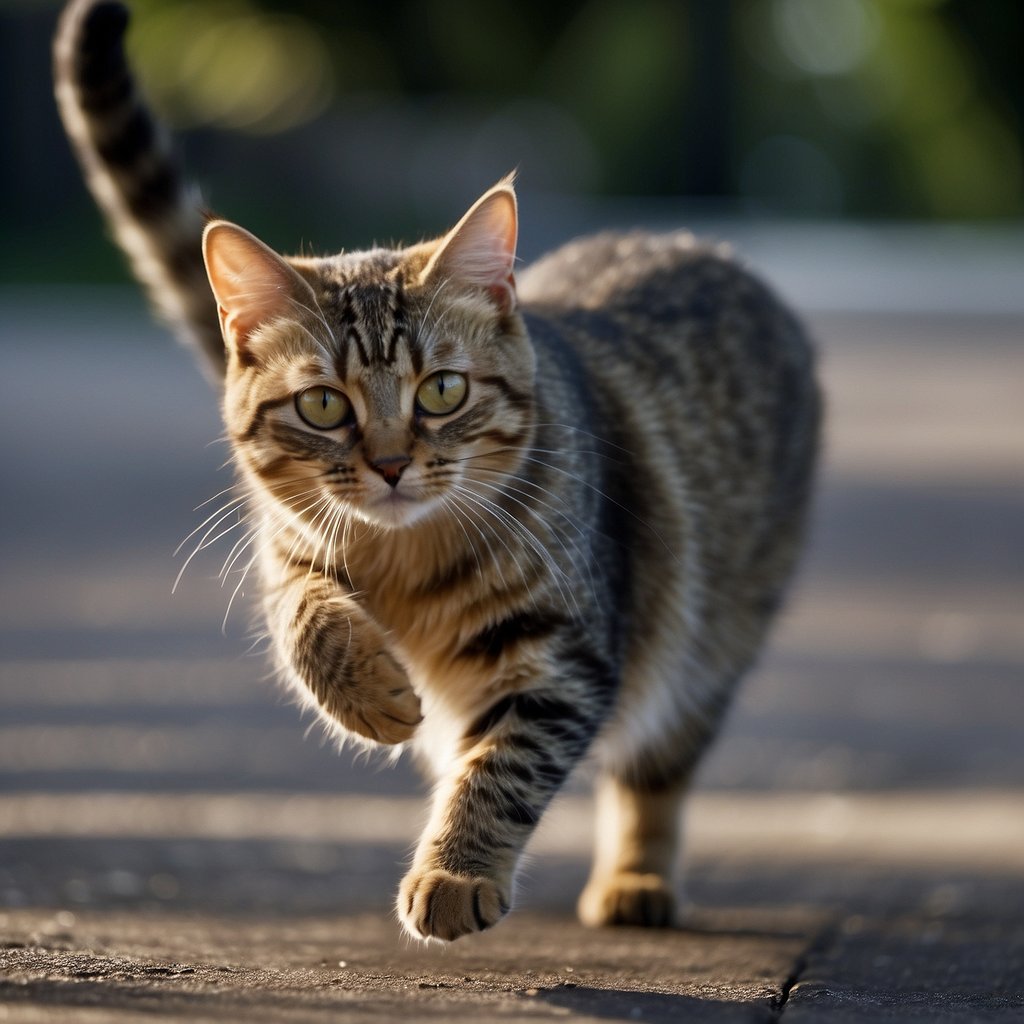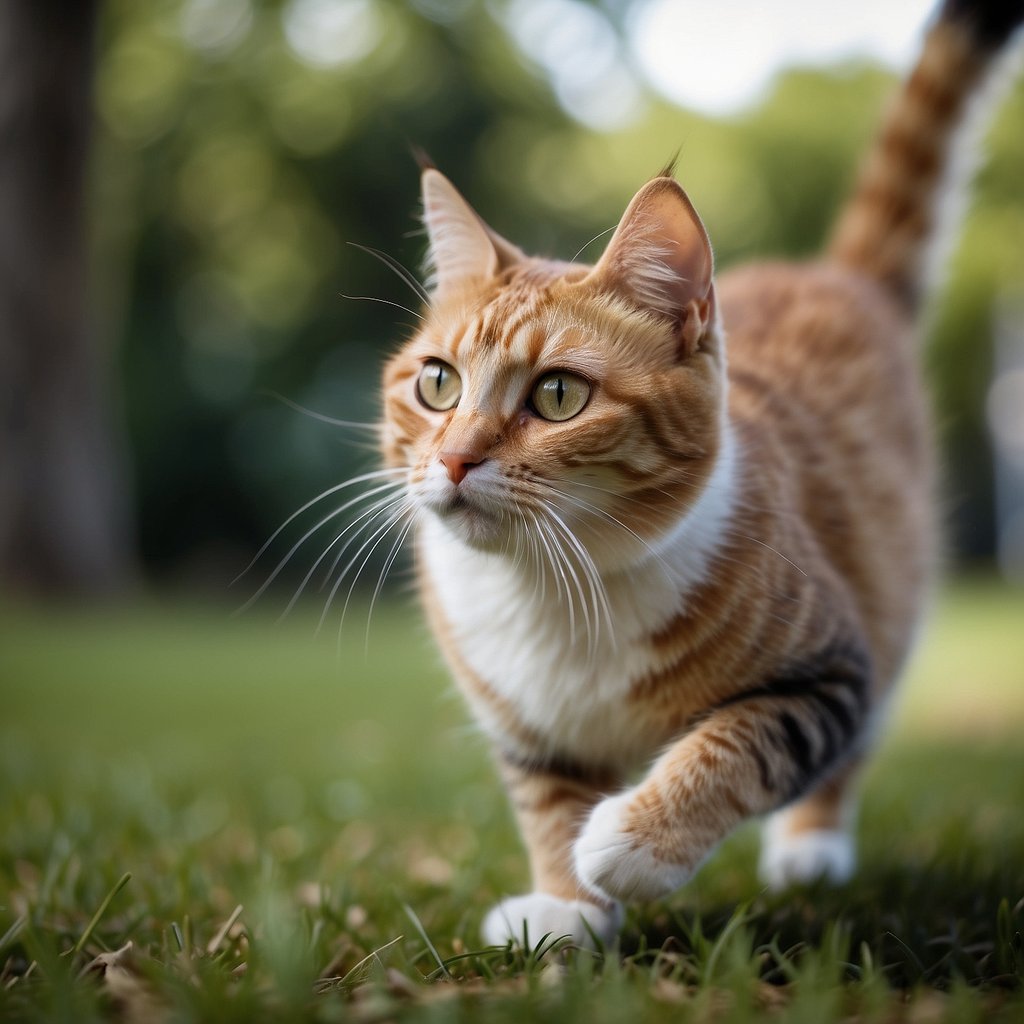
Why Do Cats Chase Their Tails: Exploring Cat Behavior
Cats chasing their tails is a behavior that has fascinated and amused cat owners for years. It is often observed in kittens and young cats, although adult cats may engage in this peculiar activity as well. Tail chasing can be a normal part of play that helps a cat develop coordination and hunting skills. It also allows them to expend energy and satisfy their innate predatory instincts. This form of play is often self-rewarding for the cat, reinforcing the behavior each time they engage in it.
Sometimes, however, tail chasing may be indicative of underlying health or behavioral issues. It’s important for owners to distinguish between playful chasing and compulsive behaviors. Health problems such as skin conditions, parasites, or neurological issues can lead to tail chasing that is excessive or seems driven by discomfort. On the behavioral side, stress, anxiety, or a lack of mental stimulation and physical activity might manifest in this repetitive action. Owners should monitor their cats for signs of distress and consult with a veterinarian if tail chasing becomes incessant or seems to be accompanied by pain.
Key Takeaways
- Tail chasing in cats is often a normal part of play and development.
- Persistent tail chasing could signal underlying health or behavioral issues.
- Monitoring behavior and consulting a veterinarian is advisable if tail chasing is excessive.
Tail Chasing in Cats
Tail chasing in cats can be a normal behavior, often seen as a form of entertainment or play. However, when this activity becomes excessive, it may indicate underlying issues such as boredom or stress.
Normal Versus Compulsive Tail Chasing
Normal Behavior:
- Play Sessions: Cats may chase their tails as part of natural play. It’s common for kittens and young cats to engage in this behavior during their active hours.
- Entertainment: A tail can serve as a convenient toy, providing self-entertainment for cats, especially in the absence of other stimuli.
Compulsive Behavior:
- Boredom or Stress: Excessive tail chasing might be a sign of boredom or stress in a cat’s environment.
- Underlying Issues: Persistent tail chasing is sometimes linked to compulsive disorders. Such behavior warrants attention and possibly a veterinary consultation to rule out health concerns.
Health and Medical Concerns
When cats chase their tails, it may seem like playful behavior, but at times it can indicate underlying health and medical concerns. These issues can range from common infections to behavioral disorders.
Common Infections and Infestations
Infections: Cats might chase their tail due to discomfort caused by tail infections. A bitten or injured tail can become infected, resulting in pain and swelling, prompting a cat to bite or chase its tail more. Veterinarian inspection is crucial to diagnose the issue and prevent it from escalating.
- Fleas and Parasites: Infestations can cause intense itchiness and distress, leading to tail-chasing. Fleas in particular are known for causing irritation around a cat’s tail base, anal sacs, and hindquarters.
- Signs: Excessive grooming, biting near the tail, redness or swelling
- Diagnosis: Veterinarian will check for fleas, flea dirt, or other parasites
- Treatment: Anti-parasitic medications and environmental control measures
Allergies: Food and skin allergies can manifest as skin irritation or inflammation, which may cause a cat to chase their tail due to the discomfort.
- Symptoms: Scratching, licking, or biting at the skin, potential gastrointestinal upset if related to food allergies
Feline Hyperesthesia Syndrome
Feline Hyperesthesia Syndrome (FHS) is a neurological disorder that may cause cats to exhibit extreme reactions to touch or stimuli around the tail area. It is characterized by sudden, aggressive behavior, which sometimes includes chasing the tail.
- Symptoms: Skin rippling, sensitivity along the spine, sudden aggressive periods of tail biting or chasing
- Diagnosis: Requires a thorough medical examination since FHS symptoms can overlap with other conditions
- Management: Treatment may include medications to reduce stress or control seizures, modifying the environment, and providing a stable routine
Hyperesthesia: This condition can be stress-induced, and indoor cats with a lack of stimulation may display symptoms. Pet owners who observe their cats exhibiting excessive tail-chasing or signs of hyperesthesia should consult a veterinarian to determine if there is a medical condition that needs to be addressed.
It’s essential to observe your pet for other signs of distress, health issues, or changes in behavior, as these could be indicators of a more significant medical concern.

Behavioral and Psychological Factors
Cats may chase their tails due to a variety of behavioral and psychological factors including stress, anxiety, boredom, and the need for mental stimulation. Understanding these factors can help cat owners identify and address potential issues to improve their cat’s well-being.
Stress, Anxiety, and Boredom
Cats experience stress and anxiety just as humans do, and these emotional states can result in a range of behaviors including tail chasing. Stress in cats can be induced by environmental changes, conflicts with other animals, or feelings of insecurity. Signs that a cat is stressed might involve:
- Increased aggression or fearfulness
- Changes in eating or sleeping habits
- Excessive grooming (itching or irritation)
For some cats, chasing their tail might be a way to redirect their anxiety or discomfort into a physical activity. It is a coping mechanism that can sometimes become a behavioral issue if left unchecked.
Boredom is another significant factor and relates to the cat’s need for entertainment and mental stimulation. Without adequate physical and mental exercise, cats may develop compulsive disorders, leading them to exhibit repetitive behaviors such as tail chasing. Providing interactive toys, engaging playtime, and creating a stimulating environment can help mitigate these behaviors.
It’s essential for cat owners to monitor their cat’s behavior and provide a supportive environment that addresses their psychological needs to prevent such behaviors from becoming problematic. If a cat is persistently chasing its tail, consulting with a veterinarian or animal behaviorist may be necessary as it could be indicative of an underlying issue that might require intervention.
Physical Aspects of Tail Chasing
Cats may chase their tails for various reasons, with physical stimulation and sensory feedback being key factors. The behavior can be playful or symptomatic of hyperesthesia, a condition causing increased sensitivity to touch or other stimuli.
Physical Stimulation and Sensory Feedback
Playfulness: Young cats often exhibit tail-chasing as part of their playful behavior. The movement of a cat’s own tail can trigger its predatory instincts, providing both physical exercise and mental stimulation. During these playful pursuits, cats might exhibit dilated pupils and engage in light biting of the tail, which is normal for a healthy kitten or young cat.
Sensory Experience: A cat’s tail has numerous nerve endings that provide valuable sensory feedback, contributing to its agility and balance. The act of tail chasing may offer the cat a type of physical stimulation necessary for its well-being, comparable to the role of enrichment activities that prevent boredom in captive animals.
Hyperesthesia: For some felines, tail chasing can be a response to hyperesthesia, a condition where the cat has an abnormal increase in sensitivity to stimuli of the skin. Signs of hyperesthesia may include skin twitching, intense scratching or biting at the tail, to the point of causing injury.
Contrast with Canines: It is worth noting that while dogs may chase their tails due to behavioral issues, cats typically engage in tail chasing for physical stimulation or as a playful activity. However, persistent tail chasing in cats, especially beyond the playful years, can also be indicative of medical or behavioral issues and should be monitored.
Preventive Measures and Treatment
The prevention and treatment of tail-chasing in cats revolve around addressing the underlying causes, which often include behavioral boredom or medical issues. Ensuring environmental enrichment and seeking veterinary guidance are fundamental strategies for mitigating this behavior.
Environmental Enrichment
Cats, including specific breeds such as Siamese, require stimulation to prevent boredom and stress. Owners can provide environmental enrichment through various means:
- Interactive toys: Encourage natural hunting behaviors with toys that move unpredictably.
- Play sessions: Regular play sessions can redirect energy away from tail-chasing.
- Scratching posts: They cater to the cat’s instinctual scratching and allow for stretching.
- Tunnels: Tunnels and hideaways help cats satisfy their curiosity and play hide-and-seek.
Environmental enrichment is particularly crucial for indoor cats that might not have access to diverse stimuli.
Veterinary Care and Advice
Consulting a veterinarian is critical, especially if an older cat suddenly starts chasing its tail, which could indicate a medical issue. A veterinarian may check for:
- Anal glands: Uncomfortable or impacted anal glands can cause tail-chasing due to irritation.
- Body language: A vet can interpret body language to determine if the behavior is playful or indicative of discomfort.
The vet may suggest a tailored treatment plan or behavioral therapy to alleviate the issue. They can also provide advice for owners on how to understand and respond to their cat’s needs.
Understanding and Responding to Tail Chasing
Cats chase their tails for a variety of reasons that range from play and exploration to possible health concerns. Tail chasing could be a simple form of entertainment or an outlet for pent-up energy, but it can also indicate boredom, stress, or even medical issues that require a veterinarian’s attention.
When to Seek Professional Help
Tail chasing behavior is often benign, especially if observed in kittens who are exploring their environment and testing their motor skills. However, veterinary advice should be sought if an adult cat’s tail chasing is:
- Excessive or frantic
- Accompanied by fur loss, skin damage, or signs of pain
- Occurring alongside other behavior changes that may suggest stress or anxiety
Certain conditions like feline hyperesthesia syndrome, which is a neurological disorder, or issues with their anal glands, may manifest in excessive tail chasing. Thus, these behaviors warrant a professional assessment by a veterinarian. They may recommend everything from environmental enrichment to medication, depending on the diagnosis.
Playing With Your Cat
Interactive play is key in providing both mental and physical stimulation for cats, which can reduce occurrences of tail chasing spurred by boredom or stress. Here are a few strategies for engaging play:
- Use a wand toy to mimic prey movements and capture their attention.
- Schedule regular play sessions throughout the day to provide consistent entertainment.
- Incorporate puzzle feeders to stimulate their sense of exploration and satisfy their hunting instincts.
Engaging a cat in interactive play not only offers exercise but also strengthens the bond between cat and owner.

Final Thoughts on Feline Tail Chasing
When observing cats, one may notice the occasional bout of tail chasing. This behavior is a blend of instinct, curiosity, and sometimes, a signal of underlying stress or anxiety. It is a common and typically harmless expression of feline playfulness, especially in kittens who are discovering their own bodies. The motion of a flicking tail can trigger a cat’s predatory instincts, turning their tail into an enticing target.
However, when tail chasing becomes frequent or obsessive, it might be a cause for concern, indicating that the cat could be experiencing distress. Environmental factors, health issues, or a lack of stimulation may exacerbate this behavior. Owners should monitor their cats for other signs of discomfort or changes in behavior parallel to the tail chasing.
In some cases, a medical issue such as a tail injury or neuroma could be the cause, warranting a consultation with a veterinarian. If the behavior is anxiety-driven, providing a secure and enriching environment with plenty of play can help alleviate the issue. Cat owners should ensure their pets have enough mental and physical stimuli to deter them from excessive tail chasing.
It is important to note that tail chasing, when not excessive, is a natural aspect of feline behavior. Casual tail chasing should not automatically raise alarms, but should rather be seen within the broader context of the cat’s overall behavior and environment. As with any aspect of pet health and well-being, vigilance and understanding of one’s cat will guide appropriate responses to their actions.
Cat Behavior Insights
Cats exhibit a variety of behaviors that are influenced by their instincts and environment. By understanding these behaviors, owners can better comprehend their feline companions.
Comparative Behavior: Cats Versus Dogs
Cats and dogs display distinctly different behavioral patterns due to their evolutionary paths. The behavior of tail chasing in cats often draws comparisons with dogs, but the motivations and implications differ between the species.
- Hunting instinct: Cats may chase their tails as a playful manifestation of their natural hunting instinct. While both species possess this instinct, cats are solitary hunters and may practice these skills even in non-threat environments.
- Normal behavior: Tail chasing in dogs is often considered normal behavior, especially in puppies. However, when adult cats engage in tail chasing, it can be a sign of playfulness or an attempt to catch something that has caught their attention.
- Sensory stimulation: Cats have sebaceous glands at the base of their tails, which can cause sensations that might trigger a chase response. This contrasts with dogs, where tail chasing might not be linked to such glands.
- Health-related issues: Sometimes, cats chase their tails due to irritation or discomfort caused by anal sac issues or after a bowel movement. In dogs, similar behavior might indicate an anal sac problem or, in some cases, a behavioral condition.
By observing feline behavior like tail chasing within the appropriate context, owners can discern whether their cat is engaging in a harmless, playful activity or if the behavior might signal a health concern that requires a veterinary consultation.
Enrichment Ideas and Activities
To mitigate boredom and encourage physical activity in cats, owners can introduce various enrichment strategies that promote mental stimulation and play. Here are some practical ideas:
Interactive Toys: Toys that mimic prey and feather wands, can captivate a cat’s attention and encourage the natural urge to hunt. Regular play sessions with these toys can help keep cats physically active and mentally engaged.
- Tunnels and Boxes: Simple cardboard boxes or cat tunnels offer cats an opportunity for exploration and play. Cats enjoy the act of hiding and pouncing, which these structures easily facilitate.
Scratching Posts: To support their instinctual scratching behavior, which keeps their claws healthy and provides a form of exercise, scratching posts in various textures and heights are essential.
Puzzle Feeders: These are excellent tools for combining feeding with mental stimulation. Cats must work to retrieve their food, which can help slow down fast eaters and keep a cat’s mind sharp.
- Daily Play Sessions: Consistent interaction between cats and their owners during play sessions helps strengthen their bond and ensures that cats receive the stimulation they crave.
By integrating these activities into a cat’s daily routine, owners can ensure their pets receive the necessary enrichment for a well-balanced and content life. These tactics also address the natural behaviors that may lead to a cat’s fascination with their tail, redirecting their energy into positive and fulfilling activities.
The Cat’s Tail as a Communication Tool
The tail of a cat functions as a sophisticated communication device in their behavioral repertoire. It is an extension of their body language, signaling various emotional states and intentions. When a cat holds its tail upright, it often indicates a friendly approach to humans or other animals, akin to a flagpole greeting. Conversely, a twitching or thrashing tail can express irritation or discomfort.
Cats may also chase their tails as part of playful behavior, seeking mental stimulation and physical activity. Tail chasing in cats could be driven by curiosity or the enjoyment of exploring their own ability to catch what seems to be a moving target. However, excessive tail chasing can sometimes be a sign of anxiety or behavioral issues.
| Behavioral Cue | Possible Meaning |
|---|---|
| Upright Tail | Friendliness, confidence |
| Thrashing Tail | Discomfort, annoyance, agitation |
| Tail Chasing | Playfulness, hunting practice |
While tail chasing might be amusing, it’s crucial to discern whether a cat is simply being playful or if it’s a manifestation of anxiety. Pheromones released from glands near the tail can also stimulate a cat to chase, as these scents are part of their territorial marking and communication.
Tail movements are not purely self-directed; they serve as signals to others, including humans, dogs, and other cats. Observing a cat’s tail can provide insights into its emotional state and behavioral needs. It is essential to interpret these cues within context to understand whether a cat is experiencing pleasure from playful tail chasing or if there are underlying issues like pain or discomfort that need attention.

Frequently Asked Questions
Cats chase their tails for various reasons, ranging from playfulness to underlying medical conditions. This section addresses common inquiries about this behavior.
What motivates a cat to chase and bite its own tail?
A cat may chase and bite its tail as part of a play behavior, driven by their natural predatory instincts. It can also be a way for cats to expend energy and satisfy their hunting urge.
Is it normal for kittens to chase their tails as part of play?
Yes, it’s normal for kittens to chase their tails as part of their play routine. This activity helps them develop coordination and satisfies their instinctual hunting behaviors.
How should you interpret your cat’s tail-chasing and meowing behavior?
Tail-chasing accompanied by meowing might be a way for a cat to attract attention or express excitement. It’s important to observe the context and frequency to understand their specific communication.
Could my cat’s tail-chasing be a sign of a medical or behavioral issue?
Persistent tail-chasing can be indicative of medical issues like fleas, skin infections, or neuropathic pain. Alternatively, it may point to behavioral issues such as anxiety or compulsive behavior.
What does it indicate when a cat aggressively chases and growls at its tail?
Aggressive tail-chasing accompanied by growling may suggest discomfort or irritation. This could be due to a physical ailment or stress and warrants closer observation and possibly a veterinary consultation.
Are there any specific meanings behind cats adopting a tail-chasing posture during activities like yoga?
Cats may mirror their owners’ activities and chase their tails during activities like yoga due to curiosity or a desire to engage with their owner. A tail-chasing posture isn’t specifically related to the activities, but more so to the interaction opportunity.